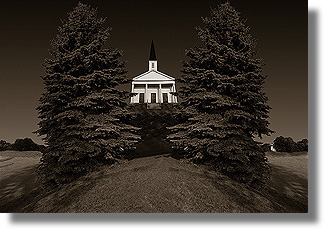|
For the past twenty-five years I have been photographing
church architecture in the United States. The church is
where its followers worship, baptize their babies, look for
guidance, socialize, and bury the departed. These
sanctuaries are the spiritual and social heart of every
community.
Inspired by my religious beliefs, my first photographs of
churches were straight- forward and documentary in nature.
The light, as it reveals each church, has always attracted
me--drawing me toward it to record the shapes, patterns, and
the abstract qualities it creates.
The next phase of my church studies consisted of a series of
diptychs and triptychs. I began to photograph in two or
three 35mm frames consecutively and print them as one image.
Still applying a strong sense of composition, I visualized
how I would shoot the next frame and the one after that.
Finally, in the darkroom, I figured out how to bring it
together, creating unreal landscapes and reconstructing my
own architecture photographically. I was still dealing with
direct issues of photography, however, I went beyond that,
conceptualizing and creating my own imaginary places.
My digital work, which incorporates elements of my
photographs into altered digital images, emanates from the
diptych series. The photographs are first taken with a
conventional camera, digitized, and then manipulated in the
computer.
This latest exploration began last year, when I took a
six-month sabbatical from my teaching position at Daytona
Beach Community College to learn about electronic imaging. I
have not been in the darkroom since. Although I love the
beauty of a straight silver print, with this technology, I
can create images that before I could only imagine. I can
select any elements and put them into my photographs to
construct entirely different realities. Once I resolve the
digital images, they are printed in a brown duotone and
output as Canon Laser Prints, Fuji Pictographs, or Iris
Prints.
One of the biggest challenges I have found in digital
imaging is to practice restraint. It is so easy to be
seduced by the filters and effects the computer offers you
and to go too far. I want to have one foot clearly in
traditional photography so that the work maintains
believability, but has shades of incongruity that make you
realize it is not real.
My digital images are intended to be viewed as finished
prints and directly on the computer's screen. After years of
producing archival exhibition photographs, I find myself
filled with renewed passion as my work, in its most
transient form, travels across the Internet as an electronic
image.
|

